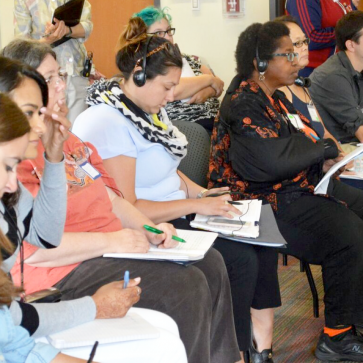Lesson Study works best with rich subject content. This course offers step-by-step support to conduct a Lesson Study cycle on fractions, by providing fractions resources and research to examine.

Conduct the Post-Lesson Discussion
While we generally think of this guide as a set of suggestions rather than a blueprint, the post-lesson discussion of the research lesson is one place where we suggest you closely follow the Protocol for Post-Lesson Discussion.
Be sure to give time between the lesson and post-lesson discussion for observers to quietly review their notes and collect their thoughts.
Distribute copies of the Protocol for Post-Lesson Discussion to all participants; specify times for each section.
Using the Protocol as a guide, discuss the data you collected and the implications of what was observed.
Protocol for Post-Lesson Discussion
- The Instructor’s Reflections: The instructor describes the goals for today’s lesson, comments on what went well and on any difficulties, and reflects on what was learned in planning and conducting today’s lesson. (5 minutes or less)
- Background Information from the Lesson Study Group Members: If observers beyond the lesson study team are in attendance, team members explain their goals for students and why they designed the lesson (and unit) as they did. (5 minutes)
- Presentation and Discussion of Data from the Research Lesson: Lesson study team members (followed by observers, if any) present data from their observations. The data have been agreed upon in advance, and may include student work, a record of questions by the teacher and/or students, narrative records of all activities by focal students or selected small groups, record of the blackboard, summary of student solution methods, etc. What do the data suggest about the students’ progress on the lesson goals and goals for long-term development? (10-30 minutes, depending on whether you will conduct items 4 and 5)
- General Discussion: A brief free discussion period, facilitated by a moderator, may be provided. The focus is on student learning and development, and on how specific elements of lesson design supported these (or not). The moderator may designate questions or themes for discussion, so that there is ordered discussion of key issues, rather than a free-for-all. Comments of a sensitive nature may be conveyed privately at a later time. If no outsiders are present, your team can summarize what you learned about student learning, and the implications for your future instruction. (variable)
- Outside Commentator (optional): An invited outside commentator may discuss the lesson in relation to key subject matter issues, link the observed lesson to larger issues in teaching and learning, and help the team consider possible next steps for instruction.
(20-30 minutes) - Thanks: Be sure to thank the instructor, planners, and attendees for their work to improve instruction.
End-of-Cycle Reflection
At the end of your team’s work together, please hold an end-of-cycle reflection meeting to consider what you have learned from this lesson study cycle. We recommend reserving one whole meeting for this reflection process, at least an hour and a half, if possible. If you are planning to revise and re-teach the lesson, we recommend that you have the end-of-cycle reflection meeting after that work.
You may want to think about the final part of the lesson study cycle as if you were preparing a presentation to school or district colleagues about what your group learned and the impact you expect from this work.
Take some time to look back over your notes and Meeting Reflection Forms from the lesson study cycle, as well as any other notes and materials (such as the lesson plan, curriculum materials, group notes, and student work).
First write individually in response to the prompt on the End-of-Cycle Reflection Form (below).
Share and discuss your thoughts, and consolidate your group learning.
You may also want to consider sharing your learning with your school or district colleagues. One option is to create a brief PowerPoint presentation that describes your team’s lesson study process and what you have learned. A Sample PowerPoint Presentation Template is included below to help you organize your ideas.


